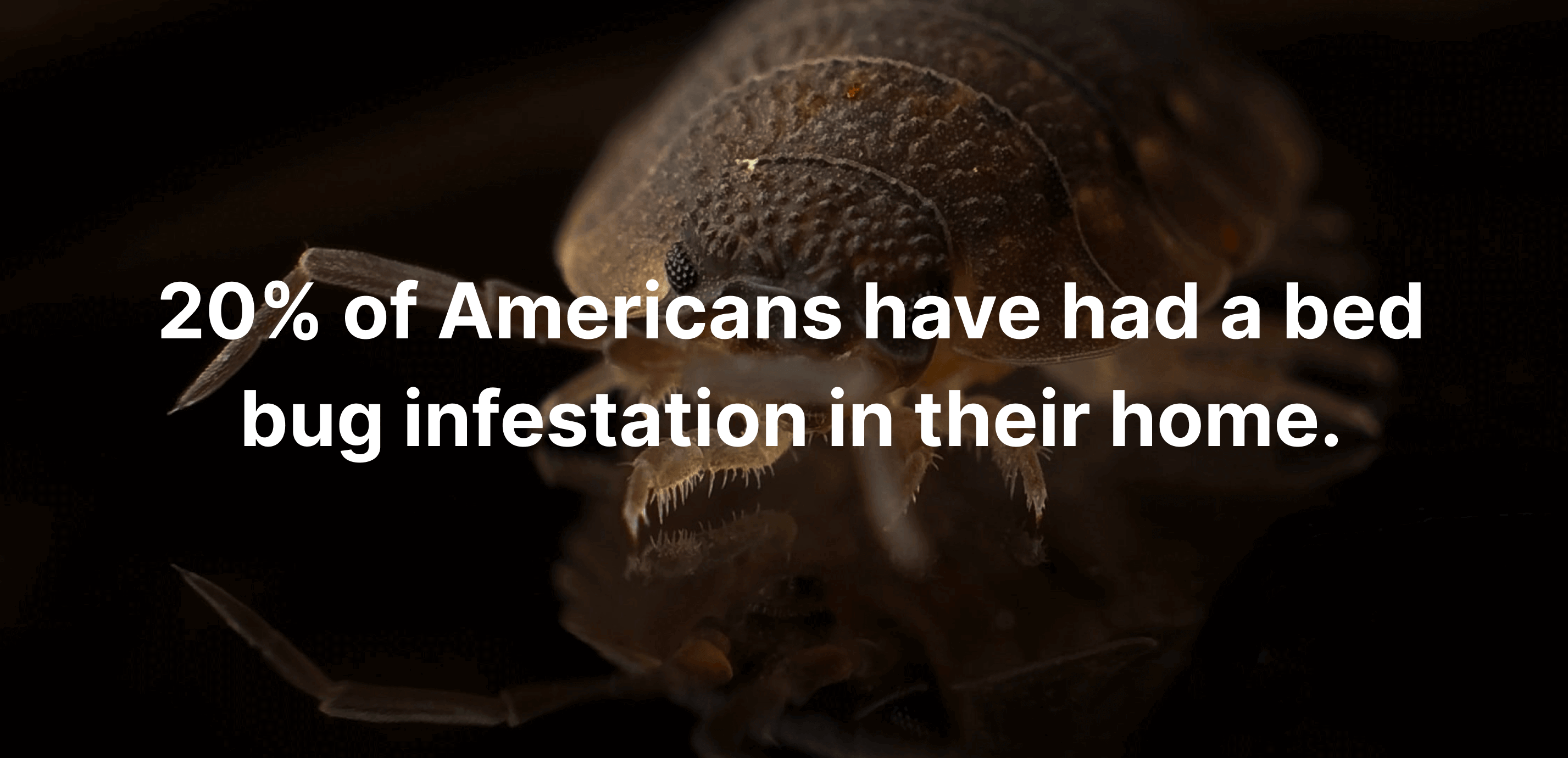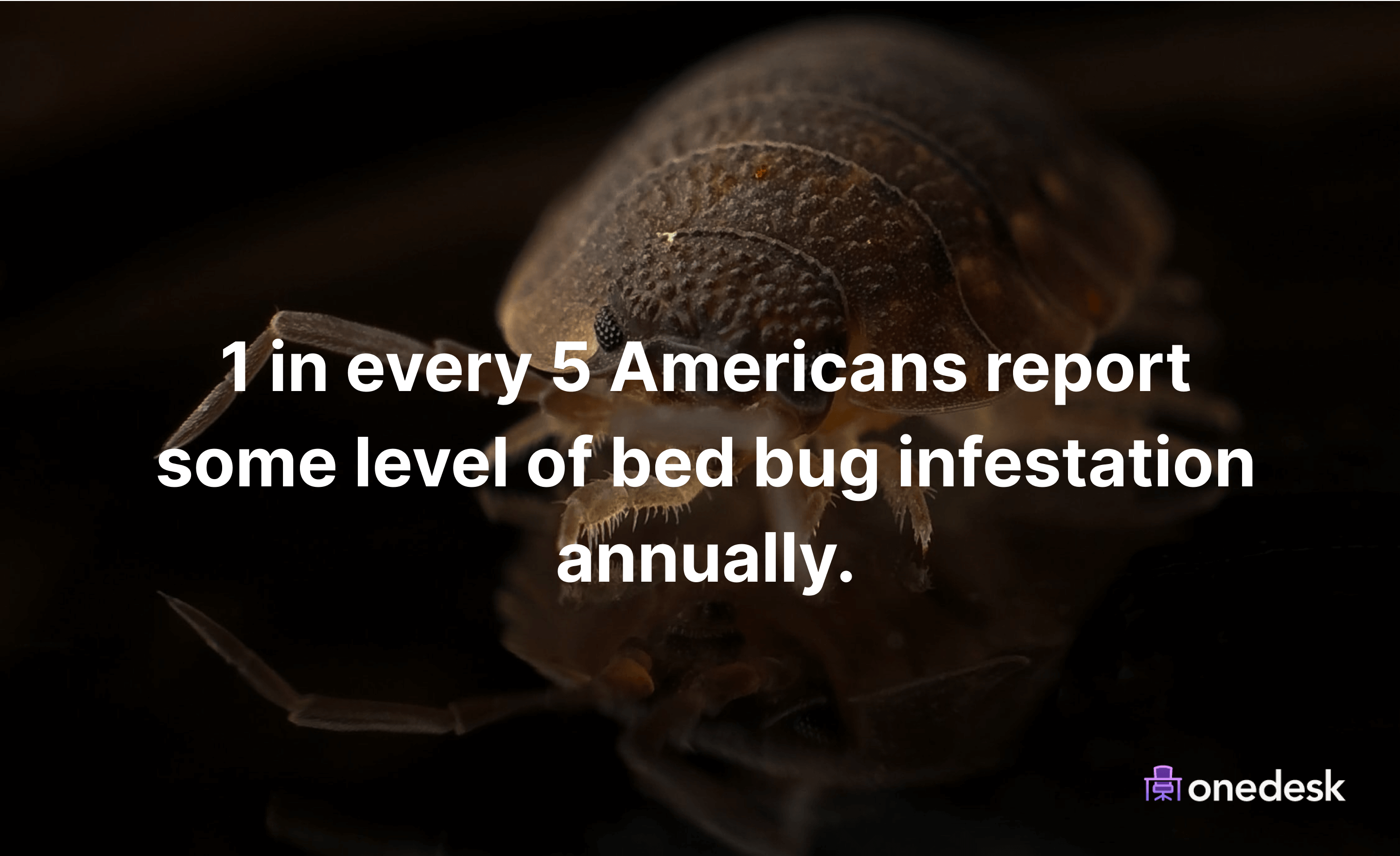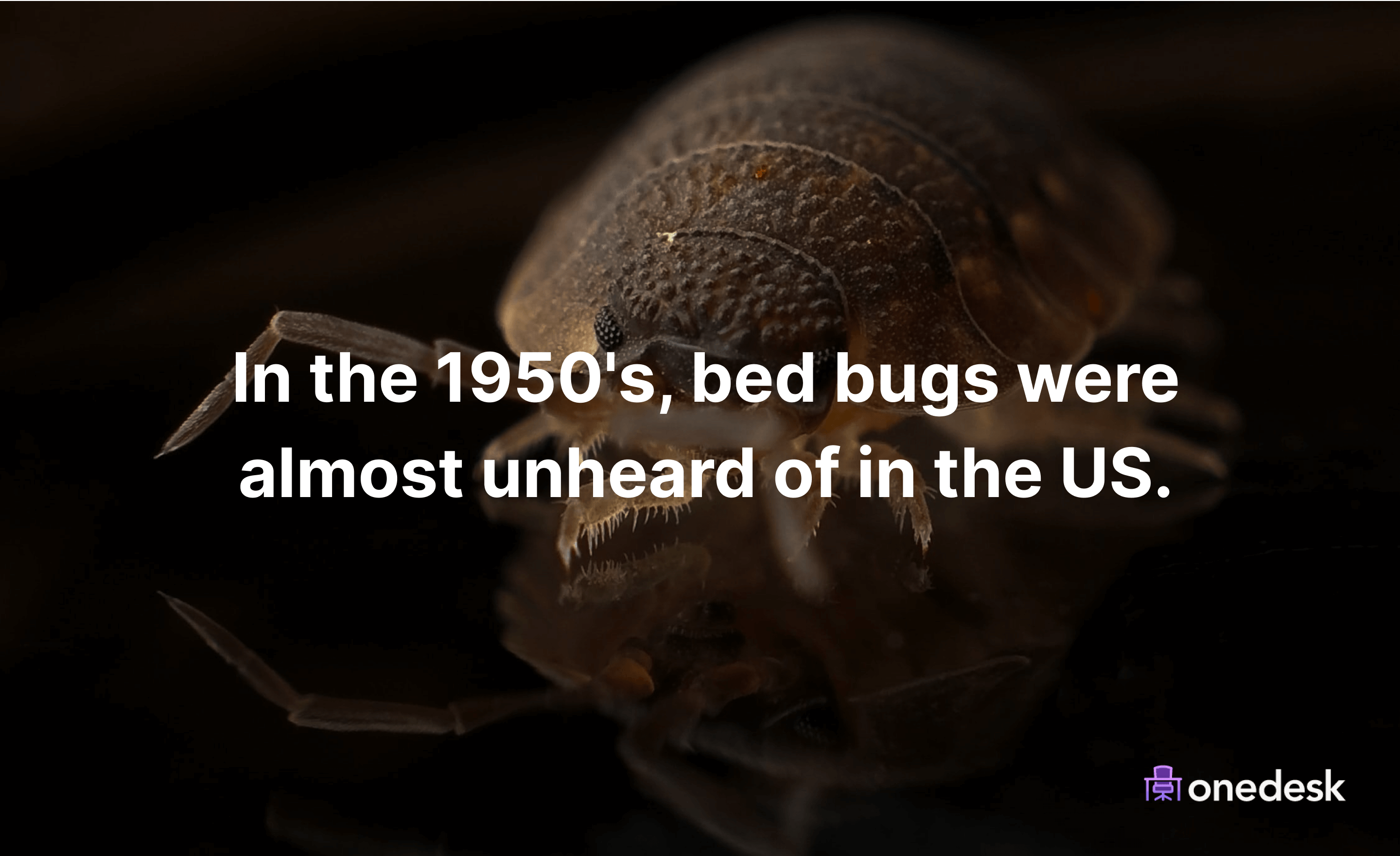How Common Are Bed Bugs? 51 Bed Bug Statistics

Key Bed Bug Statistics & Facts
- 20% of Americans have had a bed bug infestation in their home or knows someone who has encountered bed bugs.
- 97% of pest control professionals have responded to bed bug complaints in the prior year.
- Pesticide-resistant bed bugs have become common throughout the US and Europe since the 1980's.
- Exterminators report that the prevalence of bed bugs is on the rise in the US.
- The US city with the most bed bug infestations is Philadelphia.
- Ohio is considered the state with the most bed bugs.
- Almost 30% of bed bug infestations in the US are located in the Southeast.
- Bed bugs can feed for between 3 and 10 minutes at a time.
- If your skin is sensitive, you might react to a bed bug bite within an hour.
- A single female bed bug can lay 500 eggs during her lifespan.
- When temperatures are cold, bed bugs go into a state of hibernation.
How Common Are Bed Bugs?
Chapter 1: How Common Are Bed Bugs?
Bed bugs have actually become much more common in recent years, especially in the United States.
About 70 years ago, there were hardly any bed bug problems in the US. But international travel and other factors have led to an increase in this infestation.
What percentage of U.S. homes have bed bugs?

- 1 in every 5 Americans report some level of bed bug infestation annually.
- About 20% of US homes and hotels have an annual bed bug problem.
- Bed bugs are most prevalent in the Southeast region of the US, making up 29% of the country's total infestations.
- Bed bugs are least prevalent in the Northeast region of the US, with just 5% of the infestations coming from here.
Residential houses are thought to be home to almost half of all bed bug infestations.
However, many people don't realize right away that they're dealing with bed bugs.
Studies have shown that over 70% of bed bug infestations are mistaken for flea issues at first.
In fact, pest control professionals say that bed bugs were only correctly identified in about 16% of the cases they've handled.
When bed bugs aren't mistaken for fleas, they're often mistaken for cockroaches instead.
How common are bed bugs in homes?

- About 46% of total bed bug infestations are estimated to occur in one-family homes.
- About 91% of pest control professionals say they have treated bed bug infestations in one-family homes.
- 45% of pest control professionals say they've treated bed bug infestations in college dorms.
- 47% of pest control professionals mention treating bed bug infestations in professional daycare facilities as well.
While the highest percentage of reported infestations are in hotels, it's actually more common to find infestations in single family homes.
This makes sense, since there are far more residential homes than hotels in the US.
Bed bug infestations aren't always easy to identify.
Some people can have an infestation for months without realizing, especially if their skin isn't sensitive.
But others might react to the bites almost immediately.
Because not everyone reacts to bed bug bites, it's hard to accurately determine the prevalence of the bugs.
But experts agree that infestations have continued to spread for decades, and they don't show any signs of slowing down.
Bed bugs are often introduced to homes from luggage after you've stayed at a hotel or gone on an international trip.
They can also travel on your clothing.
How common are bed bugs in apartments?

- 89% of pest control professionals say they've dealt with bed bug infestations in apartment complexes.
- About 28% of the total bed bug infestations in the US are located in apartment complexes.
- Bed bugs frequently enter apartments through infested luggage after a hotel stay.
- Multiple units in an apartment complex can become infested, since bed bugs can move through the walls.
Apartments are another one of the most common areas for an infestation.
Nearly as many pest control professionals say they've dealt with infestations in apartments as in houses. In fact, about 9 out of every 10 professionals has.
What's worse is that bed bugs can spread into multiple units of a single complex.
While you might think that this could only happen after you have contact with your neighbor or touch their furniture, it's not true.
Bed bugs can move through outlets, baseboards, and any cracks in the walls.
Because of this, it's vital that landlords deal with reported infestations right away. Tenants should be on the lookout for signs of bed bug infestation.
How common are bed bugs in hotels?

- Around 68% of the reported bed bug infestations are in hotels. However, far more residential infestations are never reported.
- Bed bugs can thrive in clean and dirty areas alike, so highly rated hotels can have infestations too.
- Hilton Hotels was sued in 2018 by a guest who was bitten more than 90 times by bed bugs.
- In 2021, the Lake Louise Chateau in Canada paid $24,000 in damages to a guest after failing to fix an infestation. Prior to this, multiple guests had reported issues with bed bugs.
Most people think of hotels when they think of bed bugs.
Since people are on higher alert when it comes to infestations in hotels, these issues tend to be diagnosed and reported more quickly.
People are also more likely to correctly identify the cause of the issue, rather than attributing it to fleas or cockroaches.
Bed bugs have been reported in 5-star hotel locations.
They're not relegated to cheap and dirty environments.
It's common for bed bugs to travel into hotel rooms on a guest's luggage, and they can be well hidden when the room is cleaned.
Reports of hotel infestations must be taken seriously and investigated right away.
Like with apartment complexes, infestations can spread from room to room through the walls.
There have been times in the past when hotels were subject to litigation because of their failure to remove known bed bug infestations.
How many people have bed bugs?

- About 20% of people globally have had a bed bug infestation in their home, have experienced bed bugs in a hotel, or have known an individual with a bed bug infestation.
- The spread of bed bugs can be partially attributed to laxer airline regulations and more frequent international travel throughout the 1990's.
- Some people never notice bed bug infestations because their skin doesn't react to the bites.
- 97% of pest control professionals have dealt with a bed bug infestation in the prior year.
Bed bug infestations were on the decline in the US in the 1950's, thanks to a revolutionary pesticide.

But the bugs have since become resistant to pesticides and begun spreading through the country. They have also become more prevalent in Canada and the UK.
The number of infestations is expected to continue rising, especially as travel becomes more common following the COVID-19 pandemic.
The CDC has published robust materials about how to identify infestations and get rid of them.
How many bed bugs are in a bed?

- Any detectable presence of bed bugs can be a sign of a major infestation.
- Female bed bugs can lay 500 eggs in the span of one lifetime.
- Bed bugs often live in your mattress, particularly the edges of it. They may also nest in your bed frame.
- When not on your bed, bed bugs can also live in your carpets, furniture, clothes, walls, and baseboards.
Not every infestation is the same size. And not all bed bugs actually live in your bed.
But even if you've only found a few bugs, that's immediate cause for concern.
Bed bug infestations can multiply significantly. It only takes a few weeks for eggs to hatch, and female bugs can lay hundreds of eggs during their lifetimes.
There might truly be just a few bed bugs. There might also be hundreds or thousands.
That's why it's important to have a pest control professional evaluate the situation.
Chapter 2: Bed Bug Statistics by Country
- Bed bugs are on the rise in the US, with about 20% of Americans having dealt with some kind of infestation.
- The presence of bed bugs in developed nations has seen a significant increase since the 1980's.
- The UK saw a 24% increase in their infestations during 2010.
- In Toronto, Canada, 31% of homeless shelters reported dealing with bed bugs.
The history of bed bugs is a tumultuous one. In the 1930's, a chemist developed an effective pesticide called DDT.
This caused the number of infestations to fall sharply.
Experts also believe that vacuum cleaners played a role in the lowered infestations.
In the 1950's, bed bugs were almost unheard of in the US.
The number of infestations also fell in developed countries throughout Europe and Asia until the 1980's.
They were considered a problem of the "developing world."
But the prevalence of infestations rose significantly in the 1990's.
It has continued to increase in Europe, Canada, and the US.
Many of the bed bugs are resistant to traditional pesticides and difficult to kill. Scientists aren't sure where the pesticide-resistant bugs evolved from.
It's thought that an increase in international travel has played a role in the rise in infestations.
People are also often embarrassed to have bed bugs.
But an infestation is not a sign of a dirty environment. Bed bugs can thrive in both clean and dirty homes, as long as they have a dark place to hide and a person to feed on.
Chapter 3: Bed Bug Statistics by State
- Ohio is considered the state with the most bed bugs by Orkin, which listed 6 cities in its top concerns.
- The next states with the most bed bug infestations are Michigan, Florida, Illinois, and New York.
- According to Terminix, the most infested city in the US is Philadelphia, Pennsylvania.

All 50 states in the US have been subject to bed bug infestations. However, the prevalence varies widely.
Different regions have different levels of infestation, with temperate and warm climates being home to the worst problems.
Almost 30 percent of the country's infestations come from the Southeast.
The next most infested region is the Midwest, accounting for 21% of infestations.
The Northeast has the lowest number of infestations, possibly because of the cold and inhospitable climate.
Pest control companies often gather data on infestations and publish information about the worst-infested places in the US.
Orkin and Terminix have both done annual studies to track the prevalence and growth of bed bug infestations in the country.
Chapter 4: Bed Bug Facts
With the increasing commonness of bed bug infestations, it's important to know certain facts about the creatures.
You should be able to identify bites, know where to look for markings, and determine which parts of your environment are the most attractive to the bugs.
What is the most common place to find bed bugs?
- Bed bugs are most commonly found in the crevices of mattresses or the cracks in a box frame.
- Bed bugs often stay on luggage, which is how they can be transported so easily from place to place.
- Bed bugs can live in your walls, baseboards, electronics, and electrical outlets.

Due to their name, many people believe that bed bugs are only found in your bed.
But there are actually a variety of areas where they might live.
Bed bugs prefer to live close to their host so that they can feed easily, which is why they're so often found in your mattress.
Because bed bugs are sensitive to light, they prefer to hide in dark places.
After they feed, they will return to these dark spaces. The whole colony will often live in the same area.
If you don't find signs of infestation in your mattress, the next most common place is in the crevices of your bed frame.
But bed bugs can thrive almost anywhere. Not only can they hide in carpeting and clothing, but they can also nest in your baseboards and the walls. They don't need fabric for a habitat.
Are bed bugs seasonal?
- Bed bugs are most commonly found in the summer.
- Over 50% of pest control professionals say that they get most of their bed bug calls in the summer.
- Bed bugs thrive in temperatures from 55 to 75 F.
- In cold weather, bed bugs will hibernate and stop going through their reproductive cycle.

Bed bugs thrive in a temperate climate. Because of this, they seem to proliferate mostly in warm climates like the southeast US.
In other regions, infestations are most common in the summer. About half of all professionals say that summer is the peak time for bed bug issues.
The temperature might not be the only factor affecting the seasonality.
It's believed that infestations spread during this time because of increased travel. Families go on vacation, children go to summer camp, and other adventures.
In the northeast US, there are very few bed bug infestations reported.
This might be because this region has long and cold winters that make it difficult for bed bugs to reproduce. In addition, much of the northeast US is made up of rural towns, where it's harder for infestations to spread.
How do bed bugs bite you?
- There is a 60% higher chance of being bitten by a bed bug on the upper body than the lower body.
- Bed bug bites release antihistamines and anticoagulants into your blood, which allows them to feed for longer.
- A bed bug feeds by poking through your skin with its long beak. Then it drinks blood from the wound.

Bed bugs drink your blood by poking your skin with their beak.
They can also adapt to your sleeping patterns so that they have a higher chance of successful feeding.
You're unlikely to feel the bite at the time, because bed bugs inject substances that numb the area.
Depending on how sensitive your skin is, you might begin to feel itching anywhere from an hour to two weeks later. Some people never react to the bites at all.
How long do bed bugs bite you?

- It's common for a bed bug to keep feeding for between 3 and 10 minutes.
- Bed bug bites might not become red or itchy until 14 days have passed.
- If you have sensitive skin, bed bug bites might cause an allergic reaction within an hour. They can also take three weeks to heal.
Bed bugs feed until they become engorged. This is a process that takes several minutes.
Once they're as full as they can get, they'll roll away and return to their dark hiding place.
Blood helps bed bugs to reproduce and go through their life cycles. If you leave the lights on, they may avoid you for a while.
But when they get hungry enough, they'll come back into the open anyway.
When are bed bugs active?
- In the US, the main bed bug season lasts from June to October.
- While bed bugs tend to be nocturnal, they will adapt to the sleeping patterns of the host.
- Bed bugs are sensitive to light, so they avoid being out during the day. However, they will emerge into the light if they get hungry enough.
Most of the time, bed bugs are nocturnal. However, their sleep cycle revolves more around their host than around the clock.
If you're often awake during the night, they're more likely to be active in the daytime when you're sleeping.
Bed bugs also hibernate in cold temperatures. At that point, they aren't active at all.
Where do you check for signs of bed bugs?
- Bed bug infestations tend to be within 8 feet of your sleeping area. Experts believe that most infestations are 3 to 6 feet away.
- You should check your mattress and bed frame for signs of bed bugs. If you don't find any, check your baseboards, carpeting, electrical outlets, and any nearby furniture.
- If you've traveled recently, you might find signs of bed bugs on your luggage.
The first place to check is your mattress, after you take off your sheets and pillowcases. You might see bloodstains.
These occur when you crush bedbugs in your sleep by shifting. It's also possible that you'll see fecal matter or the remains of eggs.
Do bed bugs smell?
- Bed bugs can have a musty and sweet smell, which some people compare to the smell of berries.
- If you can smell the bed bugs in your home, you're likely dealing with a very large infestation.
Small bed bug infestations typically won't smell. But when the infestation becomes large enough, your room might take on a particularly distinct odor.
Sources
Conclusion
Bed bugs can be nasty, itchy little pests. We hope this article has shed some light on the subject of bed bugs and how you can identify them!
How To Clean Tile Floors

Now you can order cleaning services
in just 5 minutes









%20(1).jpg)






